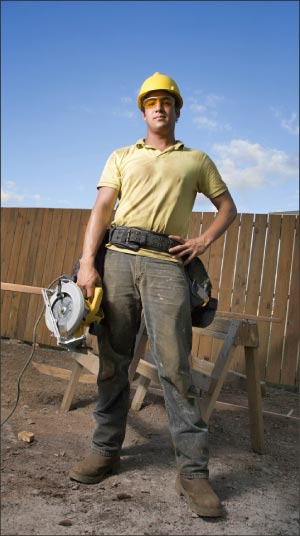Tools of the Trade
JoAnn Bertana &
Sharon Koehler
Artistic Stone Design
 A while back, I called my trusty electrician to come and install a ceiling fan in my living room. There was no prior fan or light in the ceiling, so I knew he would have to cut the sheetrock, put in a brace, run some wires and whatever else was needed to give me a working ceiling fan.
A while back, I called my trusty electrician to come and install a ceiling fan in my living room. There was no prior fan or light in the ceiling, so I knew he would have to cut the sheetrock, put in a brace, run some wires and whatever else was needed to give me a working ceiling fan.
He came at the time of our appointment. He had a tool box and a tool belt as well, plus a ladder and furniture and floor covers. He asked me several questions about the location of the fan and went to work. He put his glasses on and started measuring the room. (I had indicated I wanted the fan in the middle of the room.) He marked the ceiling and made a circle the size of the hole he was going to cut. Once he “prepped” the work area and examined the attic space above, he went out to his truck, got a saw and went to work.
He sawed things, screwed things, clipped wires, checked measurements and assembled things. He used safety glasses, saws, screwdrivers, meters, gauges, wires and things I cannot even begin to know what they are. But, in less than 45 minutes I had a new ceiling fan assembled, installed and working. Poof – just like that, the job was over and complete. I paid him, thanked him, and he went on his way.
Last month I called him again for another fan in another room but he said he was working on a huge project through the local IBEW and couldn’t do it, but he did recommend another guy he said could handle it. I called the guy, explained what I needed. He said no problem and quoted me a price that was very close to my regular electrician’s price ($5 more) so I made an appointment.
He showed up on time but not prepared. He walked back and forth to his truck a couple of times looking for his glasses. (He never found them.) He didn’t bring a ladder and asked me to find mine. Then he didn’t have the right size screwdriver, so a trip to the local supply store was necessary. Then he couldn’t find the brace he “thought” he brought, so he had to drive back to the local supply store and buy one. Then the battery in one of his gauges was dead. And then he couldn’t find the right blade to cut the sheetrock so he tried a different blade but it ended up not going through the sheetrock very well and took twice as long to cut, AND it didn’t make clean cuts. I ended up needing a hole cover to conceal the damage. Four hours later he had made four trips to the local supply store and I finally, FINALLY had a working ceiling fan (and a hole cover that I didn’t want). I paid him and he went on his way. Then I took two aspirin because I had a headache.
But while he walked away, I realized that there was a lesson in all this: Tools of the Trade!
An artist needs brushes and paints. A chef needs knives and recipes. A seamstress needs fabric and needles. So many jobs require specific tools. Stone work does too. But it’s not enough to fully stock your trucks with every bit, saw, 5 way and caulk color known to man. Tools of the trade are not just physical tools.
Tools are also customer service, knowledge and reputation. Your trucks and crews can have everything they need, but what good does it do if your salesperson aggravates the customer before the job even gets started? Plus, all those outfitted trucks won’t do you a bit of good if you have a reputation for not doing quality work, or not standing behind your work.
The right tools for the job need to start the first time the customer contacts your business. Customers want knowledge, organization and confidence. Show them that from their first contact, all the way down the line from showroom personnel, to salesperson, to templater, to installer.
But, don’t let them get all the way down the line only to have your install crew show up with only half the tools or supplies they need. All that “good stuff” the customer felt for you should not fly out the window because your trucks are not fully stocked with the tools and supplies the installers need to do the job.
Make sure your crews inventory their trucks on a regular basis to see what they need. When they do, either empower them to get it or report what they need to someone who can get it.
The “company” should also take a regular look at equipment. Things wear out over time. There is nothing more tragic than someone getting hurt because something needed to be replaced and it wasn’t.
Don’t be afraid to invest in new equipment that might make the job safer or easier. Just because you have always done it “this way” doesn’t mean “this way” should never be improved upon or changed.
From beginning to end, jobs need to go off without a hitch. Your tools of the trade will get you there and help set you apart from your competitors. Let your tools help you be the first and the best – not second and unknown.
This article was co-written by JoAnne Bertana and Sharon Koehler. Please send your thoughts on this article to Sharon@asdrva.rocks.